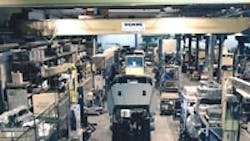Flexible Manufacturing: Doing Double Time
Oshkosh, a Wisconsin city of 63,000 about 50 miles north-northwest of Milwaukee, is best known as the home of OshKosh B'Gosh Inc., a maker of children's wear, and the Experimental Aircraft Association Inc.'s annual summer show, an event aviation buffs refer to simply as Oshkosh.
But there's another reason to know Oshkosh. It's home to $2.96 billion Oshkosh Truck Corp. and a best practice the firm has dubbed flexible integrated manufacturing. In addition to allowing the company to be more responsive to the requests of its specialized-vehicle customers, the 2,160-foot flexible integrated manufacturing line in Oshkosh Truck's 320,000-square-foot main production facility has resulted in greater efficiency, higher quality, increased capacity and less inventory. The factory, for example, once carried up to a week and a half's worth of engines in inventory; now it's 1.5 days' worth. The truck line has more than doubled production, with a cycle time per station of about 22 minutes.
The plant's production workers, about 950 in number and members of the United Auto Workers of America, also benefit from the flexibility, Bohn says. Cross-trained, they move among tasks as required by the number and types of vehicles moving down the line. "Instead of building one type of product, we've got 40 different models that go down that assembly line . . . and it's really more interesting if you have some 40 different products that you're working on," Bohn says.
Nevertheless, the transition from old ways to new took time. "We shut the factory down several times and went through extensive training" -- a day to a day and a half on JIT, for example. "They started to believe us then," Bohn says. "It was absolutely [about] changing the culture of the company. And it was probably easier to train the hourly employees than it was the salaried people," he adds. "The hourly people were already out on the floor doing the job. Salaried people are traditionally somewhere in an office and probably not next to the assembly line."
About the Author
John McClenahen
Former Senior Editor, IndustryWeek
John S. McClenahen, is an occasional essayist on the Web site of IndustryWeek, the executive management publication from which he retired in 2006. He began his journalism career as a broadcast journalist at Westinghouse Broadcasting’s KYW in Cleveland, Ohio. In May 1967, he joined Penton Media Inc. in Cleveland and in September 1967 was transferred to Washington, DC, the base from which for nearly 40 years he wrote primarily about national and international economics and politics, and corporate social responsibility.
McClenahen, a native of Ohio now residing in Maryland, is an award-winning writer and photographer. He is the author of three books of poetry, most recently An Unexpected Poet (2013), and several books of photographs, including Black, White, and Shades of Grey (2014). He also is the author of a children’s book, Henry at His Beach (2014).
His photograph “Provincetown: Fog Rising 2004” was selected for the Smithsonian Institution’s 2011 juried exhibition Artists at Work and displayed in the S. Dillon Ripley Center at the Smithsonian Institution in Washington, D.C., from June until October 2011. Five of his photographs are in the collection of St. Lawrence University and displayed on campus in Canton, New York.
John McClenahen’s essay “Incorporating America: Whitman in Context” was designated one of the five best works published in The Journal of Graduate Liberal Studies during the twelve-year editorship of R. Barry Leavis of Rollins College. John McClenahen’s several journalism prizes include the coveted Jesse H. Neal Award. He also is the author of the commemorative poem “Upon 50 Years,” celebrating the fiftieth anniversary of the founding of Wolfson College Cambridge, and appearing in “The Wolfson Review.”
John McClenahen received a B.A. (English with a minor in government) from St. Lawrence University, an M.A., (English) from Western Reserve University, and a Master of Arts in Liberal Studies from Georgetown University, where he also pursued doctoral studies. At St. Lawrence University, he was elected to academic honor societies in English and government and to Omicron Delta Kappa, the University’s highest undergraduate honor. John McClenahen was a participant in the 32nd Annual Wharton Seminars for Journalists at the Wharton School at the University of Pennsylvania in Philadelphia. During the Easter Term of the 1986 academic year, John McClenahen was the first American to hold a prestigious Press Fellowship at Wolfson College, Cambridge, in the United Kingdom.
John McClenahen has served on the Editorial Board of Confluence: The Journal of Graduate Liberal Studies and was co-founder and first editor of Liberal Studies at Georgetown. He has been a volunteer researcher on the William Steinway Diary Project at the Smithsonian Institution, Washington, D.C., and has been an assistant professorial lecturer at The George Washington University in Washington, D.C.
